Aquarium Shrimp Food: What you need to know.
Looking for a new shrimp food for your shrimp, or perhaps just want to learn more about their diet? Will look no further. This shrimp food guide will outline some of the basics of a shrimp diet, the recommended foods, commercial foods, as well as tips and tricks picked up over the years.
Table of Contents
Biofilm The Natural Shrimp Food
Biofilm is considered the number one food source for shrimp both in an aquarium and in nature. It is thus very important that we allow biofilm to grow in our shrimp tanks. Biofilm is naturally occurring and most commonly seen on the surface of decaying leaves or plant matter, often as a white “fungus” looking goo. As organic matter slowly breaks down in the water it will produce biofilm, which in turn shrimp will graze on.
LiveScience describes biofilm as follows: “Biofilms are a collective of one or more types of microorganisms that can grow on many different surfaces. Microorganisms that form biofilms include bacteria, fungi, and protists. “
The best method of adding biofilm into a shrimp tank is to add some natural leaf litter, cones or wood to the tank. It will slowly break down and provide a steady food source for shrimp to feed on. It’s worth noting that biofilm is the main food source for baby shrimp for the first 10 days when they hatch, as they will normally not consume commercial shrimp food during this time due to it being too big and unfamiliar to them.
BacterAE and Genchem Biozyme are two products that come in powder form that will assist with the growth of biofilm, and as such is highly recommended if you wish to increase the survival rate of your baby shrimp.

Top 5 Recommended Shrimp Foods
This is our list of the top 5 shrimp foods to feed your shrimp to ensure they are happy, healthy and well-fed.
SMN Shrimp – G1 Shrimp OneJump
Currently, our favourite shrimp food to feed. Complete food in a stylish reusable tin. Easy to portion out in precise pieces it’s a great food to use every day for your tanks.
Indian Almond Leaves
Simple and cost-effective. Almond leaves provide biofilm over time and also have the added anti-bacterial and fungal properties of tannins.
Shrimp Baby Food / GlasGarten – BacterAE
And either/or situation here, but some form of powdered food to help boost survival rates when we see baby shrimp in the tanks. Both baby powder food and BacterAE help to ensure they are well-fed when used in moderation.
Baby Spinach / Baby Marrow / Zucchinis
Some fresh vegetables are on the list. Cost-effective and highly nutritious for the shrimp. Ensure only organic, pesticide-free vegetables are used to avoid shrimp deaths!
Snowflake
Snowflake food is 100% pure soybean husks and does not foul the water, meaning you can leave them in the tank until they are completely consumed. There are a lot of snowflake products on the market, but we prefer a thicker “chunky” snowflake such as one from SMN Shrimps G4. Some brands of snowflake food add additional products such as spinach to their snowflake for additional nutrients.
An additional honorable mention not in the top 5:
GlasGarten – Mineral Junkie
Mineral junkie is a great mineral product that will provide any missing minerals that shrimp require to ensure a healthy shell and reduce molting problems. ShrimpNation Tip: Feed a mineral piece after a water change or when introducing new shrimp into a tank. This will ensure that if shrimp molt due to the change in parameters they have a tasty mineral treat available if needed to replace lost minerals from the molt.
What shrimp food should I buy?
The most common question we get asked is what shrimp food should I buy, or what do we recommend? Our recommendation is to get the best food that suits your current needs and your budget. If you are just starting with shrimp keeping and only have one tank with 5 shrimp in, you do not want to spend a large amount on shrimp food, but your advanced breeder that has 30+ tanks and selectively breeding the best shrimp might want to get several of the best types of food to ensure his shrimp are getting the best there is.
If you are just starting or keeping them for fun:
Our number one recommendation for people new to the hobby looking for shrimp food is to get a complete food that can be fed every time that ensures your shrimp get the basic nutrients and minerals they need to be happy. There are plenty of options on the market and you should be able to shop around to ensure it’s budget-friendly.
Have a look here at the list of some of the complete foods available
Price is often the main factor for new shrimp keepers, but another often overlooked factor is the price per gram of shrimp food. A product might look cheap and great but costs R120 ($5) for only 15 grams (8 per gram). Another food might be R280 ($15) for 60 grams which works out to 4.67 per gram. The first purchase will be cheaper upfront, but in the long run, you will spend more money as it will run out quicker than the larger product and ultimately lose. In most cases, we would recommend getting the slightly bigger pack as it saves you in the long run and will ensure you don’t need to spend money on shrimp food again for many months. Sometimes even a year.
For the intermediate keeper/breeder:
For intermediate keepers and breeders who often have multiple tanks, we would recommend you ensure you have a few basic types of shrimp foods to cover the most common scenarios. Complete food, supplementary/snack, mineral or bacteria/powdered food. At this level, it’s sometimes a bit of trial and error to figure out what shrimp food fits your style the best.
The below list of different food types should give you a good baseline of what shrimp food you can try. Or Have a look at what we currently feed on ration and give that a try.
For the expert shrimp keeper/breeder:
If you consider yourself an expert keeper or breeder, we expect you should have a handle as to which shrimp food works best for you! If you are looking for new recommendations, have a look at some of the new products on the market and try out a few sample packs to see how your shrimp reacts to it.
The different types of shrimp food
There are many different types of shrimp food available on the commercial market. Not all of them were created with the same goal in mind. Some are better to feed your shrimp every day, while some focus on scattering everywhere in the tank so that your baby shrimp can get some and others even promote the growth of biofilm and algae.
Below are a few of the different types of foods on the market. It is by no means a complete list of all products available but it lists some of the more common foods that we have encountered, tested and used.
If you want to add any foods to the growing list, drop us a message and we will test and add them to the list.
Daily Feeding or “Complete” foods
Complete foods are products that contain everything your shrimp needs to survive. A balanced diet. The product is designed to be a staple diet for your shrimp and is going to be the product you end up feeding the most. Often also referred to as a daily feed product, but please ensure you are not overfeeding and only feed your shrimp when needed.
- SMN Shrimp – G1 Shrimp Onejump
- GlasGarten Shrimp Dinner2
- NatureHolic – Shrimp Main Feed
- AWOOD – Complete Feed
- HWA’s Comprehensive Shrimp Food
- Shirakura – Ebi Dama
- Simply Shrimp – Four Seasons
- Shrimp King Complete
- MK-Breed Cheese Burger
- ShrimpExpert Churro
- NatureHolic – Main Pudding Shrimp Feed
- OG Shrimp – Everyday
Protein Foods
Protein Foods have higher levels of different proteins which help with the growth and breeding of shrimp. Often fed more regularly when growing out baby shrimp, or getting female shrimp ready for breeding to ensure they are in the best condition.
- NatureHolic – Shrimp Protein Feed
- AWOOD – Protein Feed
- SL-Aqua MORE Meat
- NatureHolic – Protein Pudding Shrimp Feed
- NatureHolic – Insect Bites
24-Hour Foods / Holiday Food
These are foods that you can safely leave in your tank for 24 hours without causing any water parameter problems such as ammonia or nitrite spikes. Other products can be left in the tank until completely consumed. Please be sure to read up on the specific product before leaving it in the tank. When in doubt it’s always better to remove it after a few hours.
- SMN Shrimp – G4 Snowflake
- GlasGarten Snowflake
- Shirakura – Ebi Dama
- GlasGarten – Crispy Cave
- Kallax Ball
- ShrimpExpert Baguette
Shrimp Baby Food
To increase the survival rate of baby shrimp special food is recommended. Newborn shrimp will survive solely off bio-film for the first 5 days, and only then start eating more commercial shrimp food. Typically most shrimp baby foods are powdered based. This is to ensure that the food spreads across the tank so that all baby shrimp have a chance to feed from it. Caution should however be taken when using this food to not overfeed as it can easily be overfed and leave particles in hard-to-reach places in the tank which could cause water quality issues.
- NatureHolic – Shrimp Baby Feed
- AWOOD – Shrimp Powder and baby food
- GlasGarten Shrimp Baby
- GlasGarten BacterAE
Mineral Based Food
Mineral-based foods contain high levels of different minerals to ensure shrimp get enough to keep their shells healthy or recover some minerals after they have just molted. They can come in different forms but their main goal is always extra mineral supplements. Expect to find them in paste, pellet, cube or pad form. For best results, it is recommended to feed this type of food once a week or once every two weeks. If you noticed a lot of molts in a shrimp tank it can also be a great time to feed this.
- GlasGarten Mineral Junkie
- GlasGarten – Mineral Hearts
- NatureHolic – Shrimp Mineral Feed
- NatureHolic – MineralCube Spinach Power / Vitamin Power / Pure Mineral
Biofilm and algae-promoting foods
Foods that help promote the growth of Biofilm. The most commonly known product around the world is BacterAE. Care should be taken with these products, as they can affect water quality and oxygen levels if overdosed and used incorrectly. As biofilm is one of the main food sources for shrimp these often also greatly help with the survival rate of baby shrimp.
- NatureHolic – Crusta Bacter Liquid
- AWOOD – Bacteria Bag
- GlasGarten BacterAE
- Lubao / Kallax Ball
- Indian Almond Leave
- SL-Aqua Magic Powder
- SL-Aqua Vitality – Bacteria Enzyme Minerals Bag
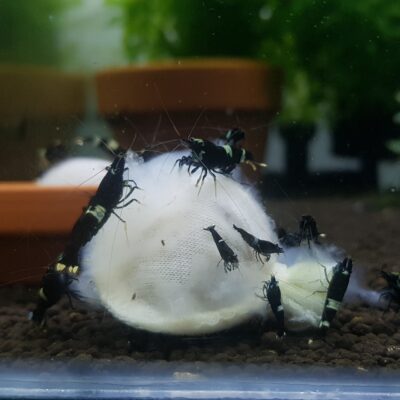
Vitamin and Bacteria
These foods are either additional additives you can use in your tank to promote shrimp health in some form or assist with building more good bacteria in your tank. Often bacteria-based products are used with setting up a shrimp tank initially, or for regular maintenance with water changes.
- SMN Shrimp – G5 Vitamin
- AWOOD – Bacterial Powder
- SMN Shrimp – G3 Ecological Paradise
- GlasGarten ShrimpFit
- SL-Aqua Milione Bacteria Powder
Shrimp Treat Foods
Shrimp treat food should be fed occasionally to treat your shrimp to something nice. It’s not something that should be fed daily as it might be lacking in one or more forms of nutrients that your shrimp needs.
- NatureHolic – Pumpkin Cinnamon Bites
- Shrimp Nation – Pure Spinach
- Shrimp Nation – Moringa Mix
- SL-Aqua MORE Vegetable
- GlasGarten Shrimp Lollies
- GlasGarten – Algae Chips
- GlasGarten Shrimp Snacks: Artemia / Dandelion / Mulberry
- MK-Breed Red Diamond
- MK-Breed White Crystal
- Natureholic – Spirulina Tabs
- Dennerle Spinach Stixx
- Dennerle Nettle Stixx
Aquarium Snail food
Aquarium snail food is a great option if you have some snails with your shrimp. The additional food will ensure that snails do not deplete the biofilm in the tank and allow shrimp to graze on it while they consume their specialized food.
- GlasGarten – Snail Dinner 54g
- Shrimp King – Snail Stixx
- NatureHolic – Snail Feed Pudding
- NatureHolic – Snail Feed
Shrimp-safe vegetables you can feed
There are a few vegetables that are shrimp safe which you can feed. When feeding vegetables it is extremely important to ensure all vegetables are pesticide-free and organic. Any form of pesticide could mean the death of your shrimp. Even vegetables that have been washed but previously treated with pesticide could pose a problem as the pesticide is absorbed and won’t wash off. We don’t recommend feeding fruit to shrimp as the sugar content can cause issues with water quality.
From our experience, spinach or baby spinach is the best vegetable to feed our shrimp. We do so once or twice a month.
Vegetables:
- Spinach
- Zucchini / Courgette / Baby Marrow
- Peas
- Lettuce
- Kale
- Cucumber
- Carrot
- Broccoli
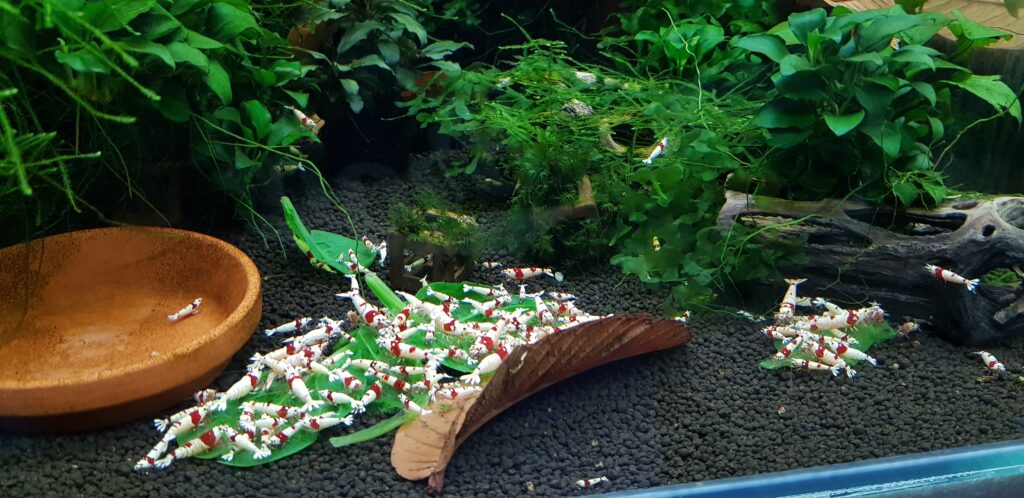
What we feed our Shrimp
In addition to the top 5 foods which we feed, we have a few other foods also in the rotation that we feed our tanks. Each tank is a different ecosystem and as such great care must be taken to ensure that they get the correct food for them.
Here is a list of the foods we currently feed and rate extremely highly (The list is in no particular order) :
- NatureHolic – MineralCube “Spinach Power”
- NatureHolic – Shrimp Main Feed
- SMN Shrimp – G1 Shrimp Onejump
- SMN Shrimp – G4 Snowflake
- GlasGarten – Mineral Junkie Bites
- GlasGarten – Shrimp Dinner2 – 70g
- GlasGarten – BacterAE
- GlasGarten – Crispy Cave
- HWA’s Comprehensive Shrimp Food
- AWOOD – Complete Feed
- Veggies (Spinach / Baby Marrow / Zucchini)
The above changes depend on what is available and the season. During summer when temperatures are hotter, more protein-rich foods and high mineral foods are used for more breeding. During the winter, more vegetable-based foods are used as breeding is slower and the shrimp’s metabolism slows down slightly.
Shrimp Feeding Photos
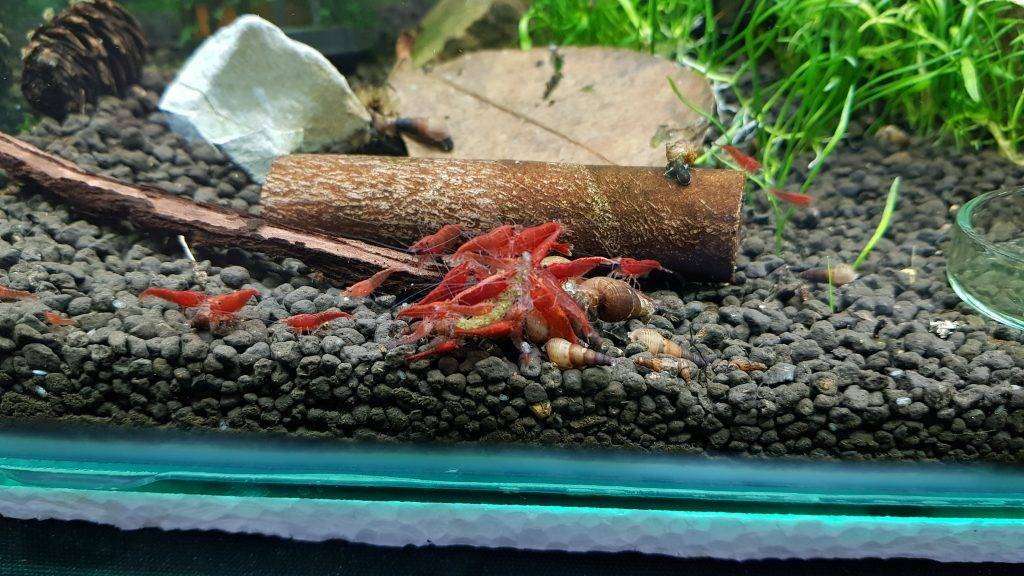
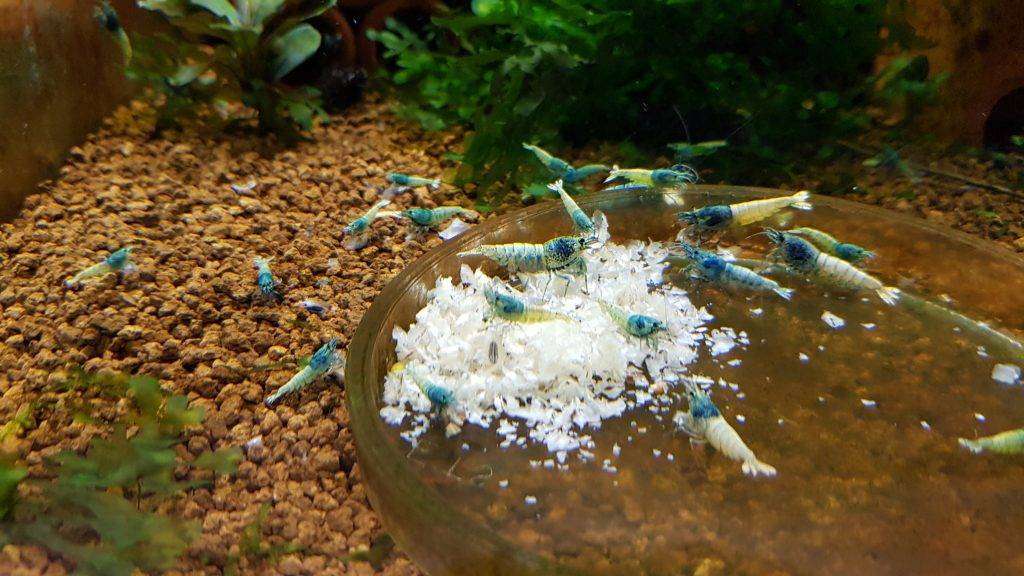
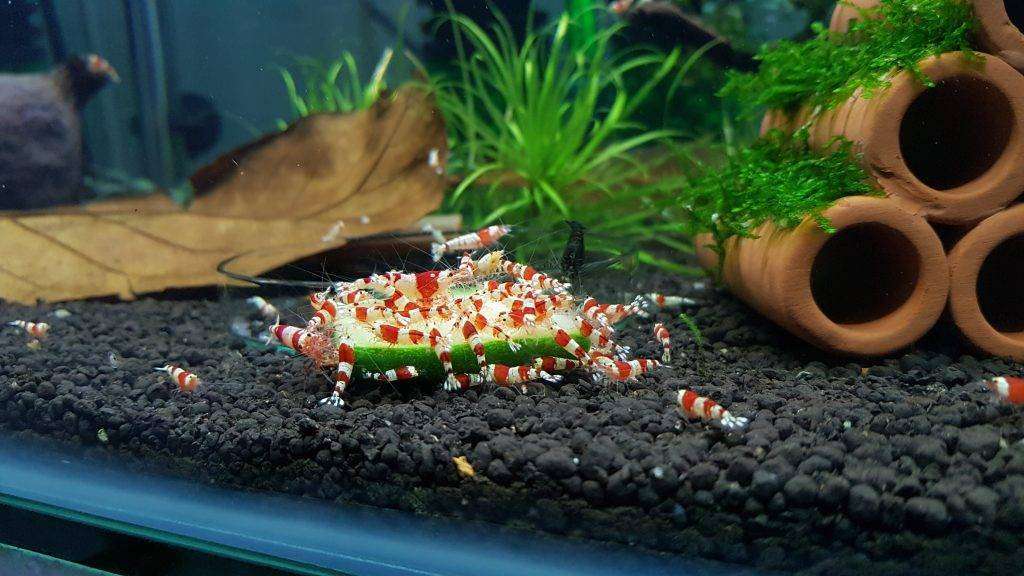

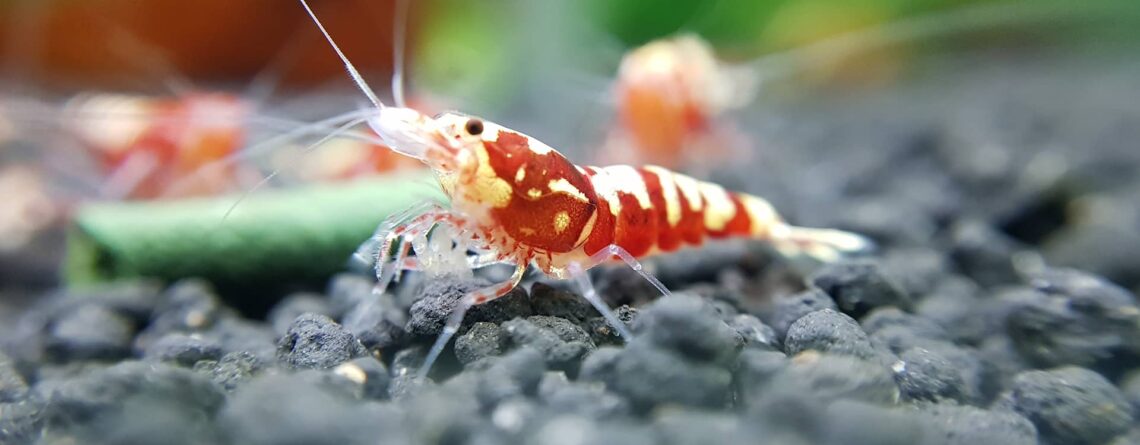
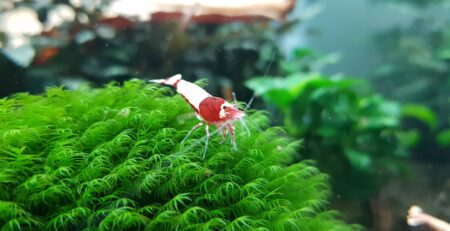
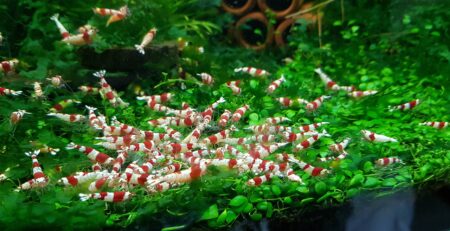
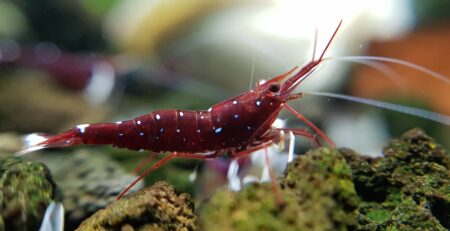
Leave a Reply
You must be logged in to post a comment.